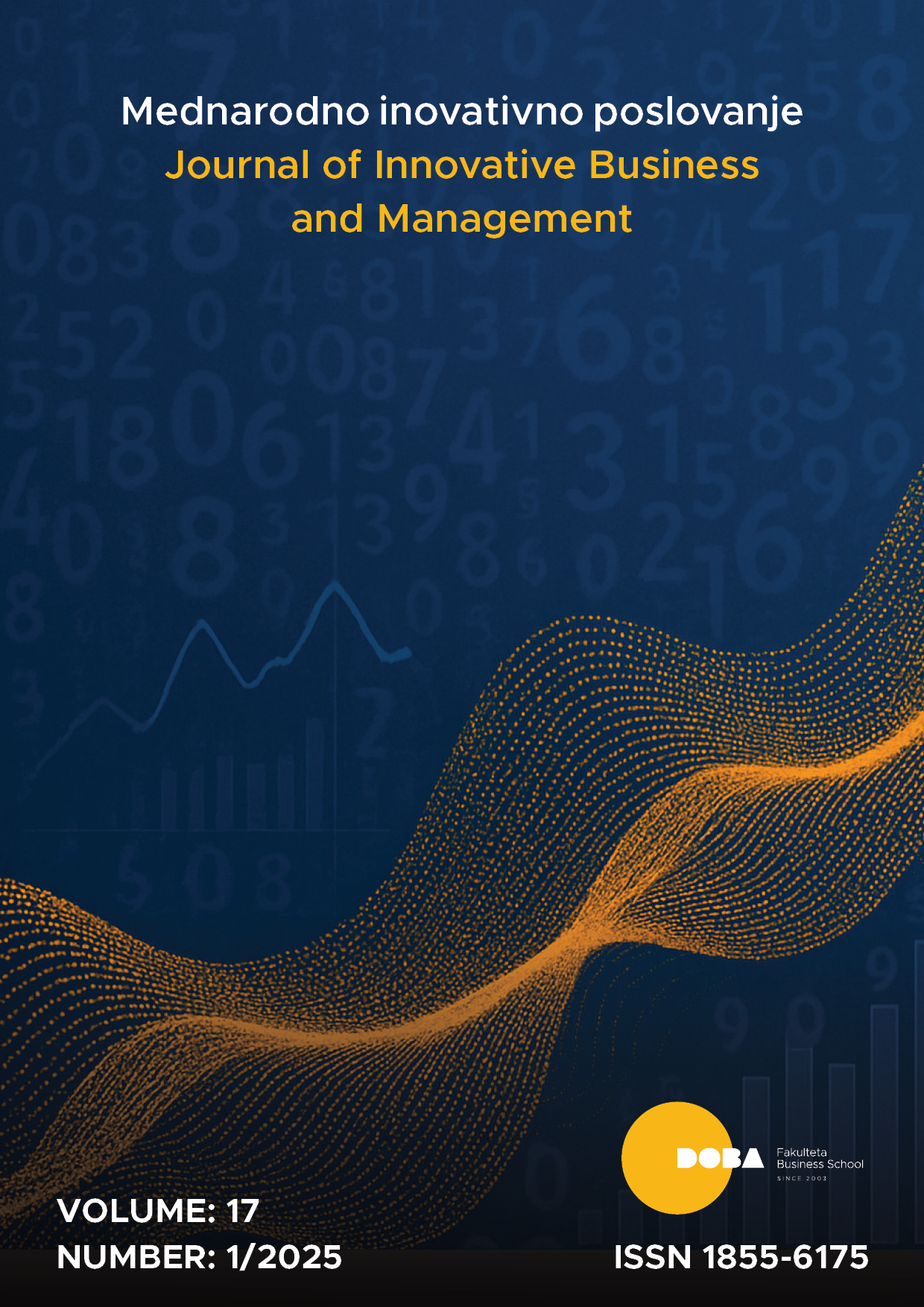Študija primera o sodelovalnem oblikovanju poslovnega kurikuluma na slovensko-italijanski meji za študente medkulturnega managementa v izobraževanju odraslih
DOI:
https://doi.org/10.32015/JIBM.2025.17.1.10Ključne besede:
čezmejni poslovni kurikulum, regionalna poslovna okolja, oblikovanje kurikuluma, čezmejna izpostavljenost, didaktična zasnovaPovzetek
Ta študija primera preučuje vpliv oblikovanja čezmejnega poslovnega kurikuluma na območju slovensko-italijanske meje, s poudarkom na magistrskem programu Medkulturni management, ki se izvaja v dveh sosednjih mestih – Novi Gorici (Slovenija) in Gorici (Italija). Program je bil sooblikovan z namenom spodbujanja čezmejne izpostavljenosti ter razvijanja kompetenc študentov za delovanje v kompleksnih regionalnih poslovnih okoljih. Didaktična zasnova temelji na štirih ključnih stebrih (model 4-stebrnega ID): sodelovalno oblikovanje kurikuluma, kontekstualizirano učenje, poglobljena čezmejna izkušnja in personalizirano učenje, pilotno pa je bil program izveden z odraslimi študenti.
Študija je potekala v treh fazah (2022–2024). V prvi fazi so bile analizirane refleksivne pripovedi 86 slovenskih magistrskih študentov poslovnih ved; v drugi fazi je bila uporabljena kratka kvantitativna samoocena čezmejnih kompetenc; v tretji fazi pa je bila izvedena pilotna raziskava s 25 udeleženci, z uporabo pred- in po-testnega dizajna.
Rezultati kažejo, da je model 4-stebrnega oblikovanja kurikuluma pomembno prispeval k razvoju študentov v treh ključnih področjih kompetenc:
(A) Čezmejna naravnanost – povečana odprtost in radovednost v medkulturnih kontekstih;
(B) Čezmejno znanje – boljše razumevanje geopolitične dinamike, zgodovinskih dediščin ter pravno-ekonomskih okvirov;
(C) Čezmejne spretnosti – okrepljene sposobnosti za upravljanje konfliktov, primerjalno mišljenje in preklapljanje pogledov v medkulturnem poslovnem okolju.
Pilotna raziskava je pokazala merljivo izboljšanje znanja in naravnanosti študentov po vključitvi v čezmejne aktivnosti. Ti rezultati kažejo, da lahko skrbno zasnovani čezmejni kurikulumi spodbujajo ključne kompetence, potrebne za strokovnjake, ki delujejo v multikulturnih in transnacionalnih okoljih. Model je širše uporaben in ga je mogoče prilagoditi tudi drugim institucijam v obmejnih regijah, ki si prizadevajo za krepitev regionalnega povezovanja preko izobraževanja.
Literatura
Almond, B. (2016) ‘Border Anxiety: Culture, Identity and Belonging’, Philosophy, Vol. 91 No. 4, S.1–19
Andersen, Dorte Jagetić (2012) Exploring the Concept of (Un)familiarity: (Un)familiarity in Border Practices and Identity-Formation at the Slovenian–Croatian Border on Istria, European Planning Studies 21 (1), pp. 42-57
Anzaldúa, G. (1987) Borderlands/La Frontera: The New Mestiza, Aunt Lute Books, San Francisco.
Beck, J. and Wassenberg, B. (Eds.), (2011) Living and researching cross-border cooperation in Europe (Volume 3): the European dimension, Stuttgart, Steiner-Verlag.
Beck, J., (2019) ‘Cross-border cooperation in Europe as an object in transdisciplinary research. An introduction’, in Beck, J. (Ed.), Transdisciplinary Discourses on Cross-Border Cooperation in Europe, Brussels, Peter Lang, pp.13–29.
Boesen, E. and Schnuer, G. (Eds.), (2017) European Borderlands. Living with Barriers and Bridges, Routledge, London and New York.
Brunet-Jailly, E. (2013) Power, Politics and Governance of Borderlands, in P. Gilles, H. Koff, C. Maganda und C. Schulz (Hrsg.), Theorizing borders through analyses of power relationship. Regional integration and social cohesion, Bd. 9, S. 29–45, Brüssel, P.I.E. Peter Lang.
Buko S. (2018): Cross-border cooperation of small and medium businesses (SMEs): business characteristics, regional perceptions, and the probability of success on the Italian-Slovenian border. Presented at the 10th Slovenian Social Science Conference on The Social Transformations We Live in: Between Cohesion and Fragmentation. Nova Gorica, Slovenia, FUDS. 20-21 September, 2018
Buko S. (2020) “Chronicles of the living borders: shared urban space of Gorizia (IT) and Nova Gorica (SLO). "Bordering in Pandemic Times. Insights into the COVID-19 Lock-down" Thematic issues 4/2020, UniGR-CBS series "Borders in Perspective" Luxembourg/Trier, 2020 DOI: https://doi.org/10.25353/ubtr-xxxx-b825-a20b
Buko S., (2019): Role of business leader’s competencies in shaping successful intercultural entrepreneurial strategies on the Italian-Slovenian border. SIETAR EUROPA conference “Building Dialogues on Diversity”; Leuven, Belgium, 27 May-2 June, 2019
Clark, J., & White, G. (2010). Experiential Learning: A Definitive Edge In The Job Market; American Journal of Business Education, 3(2), pp. 115–118.
Genova, N. (2017) The Borders of Europe. Autonomy of Migration, Tactics of Bordering, Durham, Duke University Press.
Paasi, Anssi (2009) Bounded spaces in a ‘borderless world’: border studies, power and the anatomy of territory, Journal of Power, 2(2), pp. 213-234
Selvelli, G. “Gorizia 2025: un imminente presente”. Dialoghi Mediterranei, 2020, vol. 50, pp. 464-481 (with Nicola Strizzolo).
Selvelli, G. “Gorizia e Nova Gorica. Due città allo specchio”. Futuribili XXVI (1/2) 2021, 371-386 (with Nicola Strizzolo).
Van Houtum, H. and Van Naerssen, T. (2002) Bordering, Ordering and Othering, Tijdschrift voor economische en sociale geografie, 93 (2), pp. 125-136.
Wille, C. and Nienaber, B. (Eds.), (2020) Border Experiences in Europe. Everyday Life – Working Life – Communication – Languages (Border Studies. Cultures, Spaces, Orders, Vol. 1), Nomos, Baden-Baden
Wille, C.; Gerst, D. and Krämer, H. (2021): Border Studies: A Long-Overdue Self-Examination. In: Borders in Perspective - UniGR-CBS thematic issue. Identities and Methodologies of Border Studies: Recent Empirical and Conceptual Approaches. Vol. 6, pp. 11-16. DOI: https://doi.org/10.25353/ubtr-xxxx-e930-87fc
Wille, Ch. (2020) Borders in Times of COVID-19 / Grenzen in Zeiten von COVID-19. BorderObs, UniGRCenter for Border Studies, [online] http://BorderObs.BorderStudies.org
Prenosi
Objavljeno
Številka
Rubrika
Licenca
Avtorske pravice (c) 2025 Svitlana Buko, Giustina Selvelli

To delo je licencirano pod Creative Commons Priznanje avtorstva-Nekomercialno 4.0 mednarodno licenco.
Avtorske pravice so zaščitene s Creative Commons Priznanje avtorstva-Deljenje pod enakimi pogoji 4.0 Mednarodna CC BY-SA 4.0 in jih avtorji ohranijo v okviru te licence. Za objavo svojega članka, vključno s povzetkom, prenesejo avtorji avtorske oz. licenčne pravice na revijo MIP = JIBM. To nam omogoča popolno zaščito avtorskih pravic ter razširjanje članka in revije MIP=JIBM v najširši možni krog bralcev revije v elektronski obliki. Avtorji so sami odgovorni za pridobitev dovoljenja za razmnoževanje avtorskega gradiva iz drugih virov.















